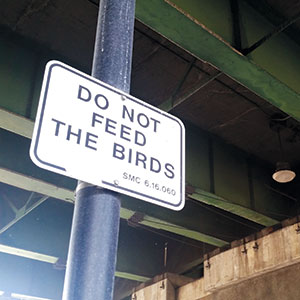

I disembarked at the Lawrence Caltrain Station intending to complain about piles of ugly condos, but ghosts of dead pigeons prevented me from doing so.
Now, I have a long history with pigeons, so let me explain. In 2007, the Mercury News kept fawning and fawning over the peregrine falcons nesting at the new San Jose City Hall. At the time, I was a restless, irritable and discontent person whose nervous system didn’t exactly process the outside world very well, so as a knee-jerk response I wrote about dead pigeons at the Lawrence Caltrain Station. Call it oppositional defiant disorder if you must, but it happened entirely by accident.
I was on my way to Palo Alto, but wasn’t feeling very well so I decided to get off the train at Lawrence Station. That’s when I saw some dead pigeons stuck in the preventative netting that authorities had installed on the steel girders running underneath the overpass.
At the time, the station had a huge pigeon problem, with hundreds of birds pooping all over the platformand anyone sitting on the benches. A massive wire mesh grid was installed, blocking off all access by the pigeons to the girders. But many birds still managed to find their way inside to the girders to nest. Unfortunately, a few who got inside didn’t have much room to fly around, so they got stuck, either crushing themselves between the mesh and the girder, or catching a body part in the mesh somehow, and then dying after being stuck for days.
Maybe I got it wrong, I don’t know, but that’s what it looked like, so that’s what I wrote.
The resulting column was forwarded all over the country, triggering many to respond and/or leave me voicemails with their opinions about pigeons. I didn’t know there was an entire industry devoted to pigeon control problems. I was so moved that I read Andrew D. Blechman’s wonderful book, “Pigeons: The Fascinating Saga of the World’s Most Revered and Reviled Bird” and then wrote a second column, relaying several intriguing facts.
To this day, I still receive emails from pigeon control companies. For whatever reason, I never removed myself from their mailing lists.
Maybe the whole experience drove me to carry some unconscious guilt, but nevertheless I have learned much in the process. For example, OvoControlpigeon birth controlcan be a safe and more humane alternative when physical deterrents aren’t feasible. In short, don’t fry the birds with electrical fences and don’t use piercing electronic noisemakers to scare them; instead, use OvoControl.
Last week, when I revisited the same station in search of ways to rail against the soon-to-be nearby homogeneous condos that nobody wants to look at, I realized I didn’t need to repeat such a tirade for the millionth time.
When I got there, I felt like the ghosts of dead pigeons had resurfaced to remind me I shouldn’t let every little instance of Silicon Valley real estate stupidity rattle my feathers. After all, pigeons and doves are essentially the same birds, and the dove is an international symbol of peace. In my case, they’re symbols for inner peace and I was obviously being reminded to maintain a more mindful perspective from which to view all of this.
To paraphrase an old wise guy from the east 2,600 years ago, the mind is like a pigeon’s digestive system in that the quality of what the mind excretes depends on what gets put into it. These days when I get agitated, I don’t need to act on the thoughts. When I see business journals publishing insidious propaganda stories for “transit villages,” I don’t always need to respond.
Here’s another way to look at it: The old wise guy said that all phenomena arose due to the coming together of previous phenomena.
Had I not disembarked from the train that one day in 2007, I wouldn’t have written that column on pigeons, the readers wouldn’t have answered and I wouldn’t have bought the book that led me to write another column and thus acquire serious knowledge of the subject. It all worked out.
Practicing mindfulness in the Covid-19 era is necessary for one’s mental health. We will get through this. We will.



